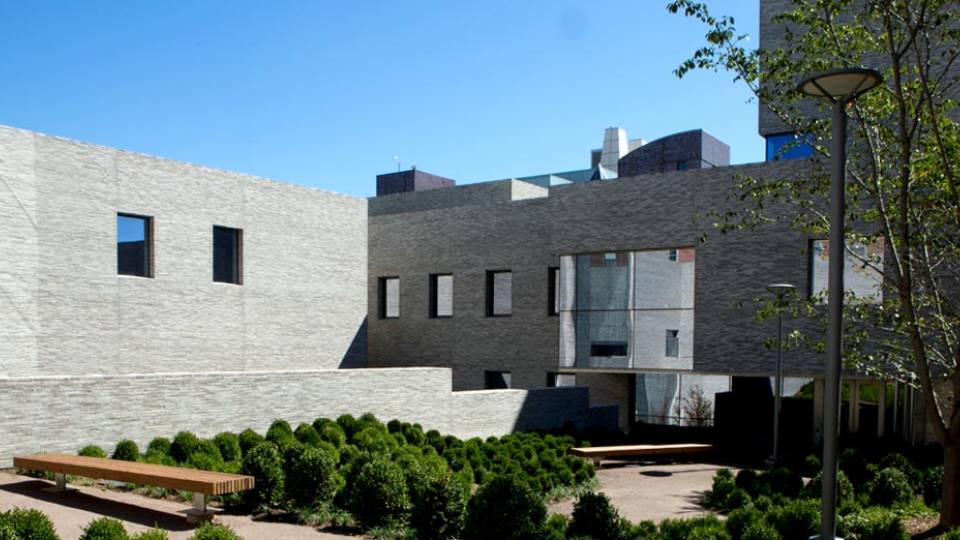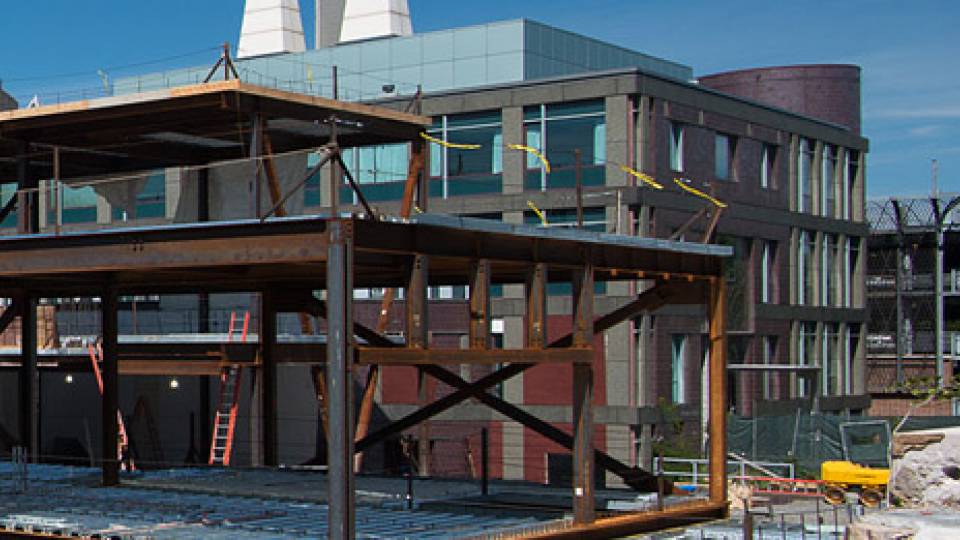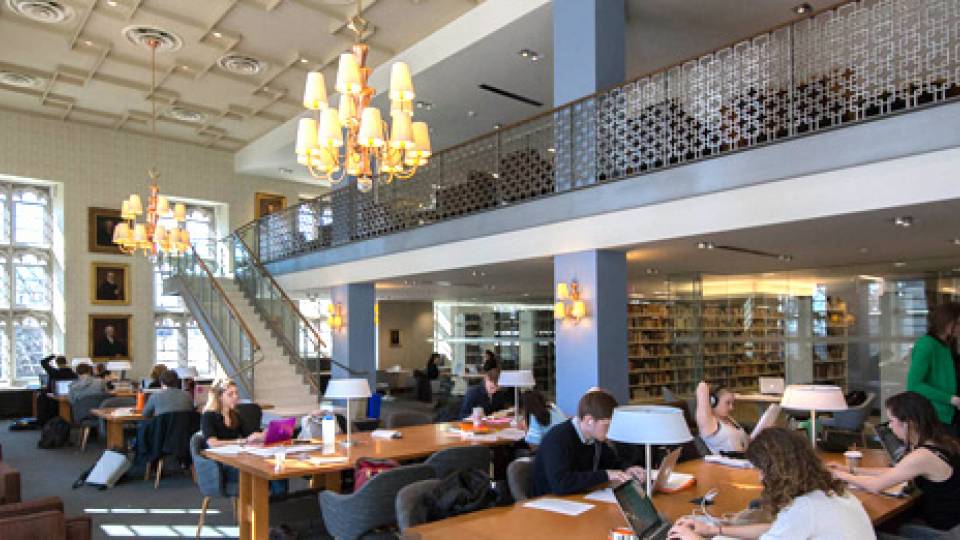When architect Billie Tsien talks about the design for the new Andlinger Center for Energy and the Environment, you can almost see the shape of the low buildings at dusk, framed by rustling gardens and lit by the quiet beacon of an illuminated tower.
"You are walking through a series of gardens," said Tsien, one of the principal designers of the new Andlinger Laboratory, which will house the center. "We thought it was important to emphasize the ground plane, the green aspects of a garden, and to bring in light by creating a series of courtyards."
Inside, researchers in brightly lit laboratories will search for new energy sources to power societies around the world. Yet the structures themselves are spare and almost primal, rooted firmly in the earth.
"These are not just huge machines," Tsien said. "You sense the human beings. You sense the hand that made things."
This merger of humanity and technology is the balance the architects of the Andlinger Lab have tried to strike. Pablo Debenedetti, vice dean of the School of Engineering and Applied Science and chair of the project's building committee, said the University wants the construction to reflect the goal of science and technology in service to the planet. Instead of a massive stand-alone laboratory building, the committee felt the design should incorporate the research space into the surrounding landscape.
"It is the idea of the center as a place," he said, "the idea of gardens that take you from one area to another. It will be a place for accomplishment, but also for thinking and contemplation."

The lab and lecture halls comprise multiple levels, allowing many of the lab facilities to be planted directly into bedrock to reduce vibration. An entrance walkway affords a view of one of the signature garden spaces as well as the large windows of the lecture hall. In this view, Prospect Street is straight ahead and Olden Street is to the right. (Image courtesy of Tod Williams Billie Tsien Architects)
Over the next three years, construction crews will build a series of linked structures in an L-shaped plot that extends back from the intersection of Olden Street and Prospect Avenue. From the street, the site will look like three two-story buildings connected by plazas, gardens and pathways. The appearance is deceptive. The Andlinger Lab is actually one building that will break through the surface of the ground like an iceberg emerging from the sea. Much of the linked structure will rest in the bedrock, which both insulates the structure and dampens vibrations that could interfere with sensitive equipment.
Two sections of the complex — housing laboratories, classrooms and offices — will fill the space between the Engineering Quadrangle and Bowen Hall. The third, at the corner of Olden and Prospect, will house a lecture hall and meeting rooms. A glass-sided tower, holding open stairwells, will rise at the connection between the central lab building and the southeastern corner of the EQuad.
The design team also worked to decrease the labs' environmental footprint. The ventilation system relies as much as possible on natural air flow, and the building will feature a heat recovery system to pull heat from exhaust air to reduce energy consumption. The roofs will hold plantings designed to filter and retain stormwater to reduce runoff and improve groundwater quality in the area.
"The Andlinger Center represents a new focus, a new discipline," said Tsien, a principal at the project's architects, Tod Williams Billie Tsien Architects of New York. "The lighted tower is a beacon, quietly locating this new facility."
Construction crews have been digging at the site and moving utility cables and pipes for the past few months. Work is scheduled to continue steadily at the site — and webcams are available to watch the progress — until the Andlinger Lab's scheduled opening in the spring of 2015.
When it is finished, the Andlinger Lab will provide 127,000 square feet of new space, about a third of the size of the EQuad. With the construction, the University is roughly doubling its available space in "clean rooms," labs suited for work so sensitive that even minute dust particles would be disruptive. The Andlinger Lab's ventilation system is powerful enough to reduce the amount of dust in the clean rooms 1,000-fold.
The facility will hold machines that can create etchings at the nanometer scale and imaging equipment detailed enough to look at individual atoms. And everything will be enfolded in a park.

Education, outreach and collaboration are key components of the mission of the Andlinger Center; the auditorium (shown here) and classroom spaces provide ample opportunity for integrating teaching and research related to energy and the environment, as well as to foster meetings and interactions among faculty, students, industrial partners and other experts in the field. (Image courtesy of Tod Williams Billie Tsien Architects)
Keeping with tradition
In 1900, Philadelphia architects Walter Cope and John Stewardson bemoaned the failure of American universities to integrate courtyards into their campuses. Not only shameful from a design standpoint, the two wrote, this was "a senseless waste of space and money."
"It is worthwhile to plan for many quadrangles, for each will develop a character of its own," they wrote. "These are the outdoor rooms, with the sky for the ceiling, which, when the sides are once completed, can never be disfigured by later additions."
Cope and Stewardson went on to claim a place among the foremost practitioners of Collegiate Gothic, the late 19th- and early 20th-century style of design that shaped many campuses in the United States. At Princeton, one of the first campuses to adopt the new Gothic style, their firm designed buildings including Blair Hall and the Ivy Club.
"The courtyard typology goes back to ancient designs, to Pompeii," said Ronald McCoy, the University architect who unearthed Cope and Stewardson's writings while researching the Andlinger project. "Courtyards can be designed for light and air. They can provide density yet also a sense of solitude and inner peace."
The use of courtyards and walks is a central element in the Princeton campus. The Andlinger Lab, with three linked garden courtyards, will form an eastern terminus of a central corridor through the University that now ends with Shapiro Walk.
"The concept is that you are entering into a garden," McCoy said. "The goal is that you don't perceive buildings; you are aware of gardens, space and nature."
The gardens will be built on three levels. The upper garden will be made up of boxwoods and the lower-level garden, which will be below grade, will hold plantings and gravel walks. The entry level will be more overtly a public space, with paved areas and seating. The landscaping will tie in with the existing plantings on Shapiro Walk, and the University plans to plant several full-sized trees in the Andlinger courtyards.
The design committee knew from the start that the project would preserve the existing wall that runs at the periphery of the site along Olden and Prospect, McCoy said. The brick wall, which follows the topography of the site and increases in height from 9 feet on Olden Street to around 20 feet along Prospect Avenue, was designed by McKim, Mead and White.
Architect Tod Williams said the vine-covered wall reflects the garden theme of the Andlinger project, and helps to create a boundary that was distinctive but not forbidding.
"It suggests that something special occurs behind this wall," he said.
The architects tried to strike a similar balance with the building material, selecting a specialized brick from Denmark to make up the exterior walls. Made in the shape of ancient Roman brick — thinner and longer than modern bricks — they are hand-cast and have a stone texture of mottled greys, warm umber and Tuscan red.
"They are not conventional red brick. They are more earthen; they almost look like slabs of stone," McCoy said. "The goal is to have a contemporary building, but one with a deep connection to the traditions of stone on the older parts of the campus."

Emily Carter, the director of the Andlinger Center for Energy and the Environment, overlooks the site of the Andlinger Laboratory. The laboratory, which will be built over the next three years, will offer state-of-the-art technical facilities for researchers and students seeking solutions to the world’s energy challenges. (Photo by Denise Applewhite)
Building for 'collisions'
When a scientist peers at a lattice of atoms, the smallest vibration can make the microscope image bounce like a cork in a stormy sea. With that in mind, the architects plan to set much of the Andlinger lab space firmly in the bedrock. The construction will shield sensitive equipment from vibration and sound.
Anthony Novembre, associate director of the Princeton Institute for the Science and Technology of Materials (known as PRISM), said the new laboratory has been designed to meet the standards of the most exacting equipment available. A typical office building vibrates at 16,000 microinches per second (a microinch is a millionth of an inch); the most sensitive sections of the Andlinger Lab will only move about 30 microinches per second. In fact, the new structure is so stable that PRISM will be moving its most sensitive equipment into the Andlinger Lab, and Novembre is part of a group advising the project's designers on technical requirements.
"The imaging and analysis center and the tools they are intending to get make us state of the art," Novembre said. "We are projecting into the future, 10 years plus."
The University is currently raising funds to purchase equipment, some of which will be designed specifically for use at Princeton. But equipment is only part of the equation. For the center to fulfill its goals, people with the right mix of expertise will need to collaborate on breakthroughs that lead to new energy technologies.
"My goal is to preserve the planet for future generations by getting us off fossil fuels," said Emily Carter, the center's director. "That's not going to happen through a snap of the fingers."
Carter said a tremendous advantage held by Princeton is the ability to draw upon researchers from a wide variety of fields — more than 90 faculty members in 16 departments are currently doing research related to energy and the environment as it is impacted by energy. Although the Andlinger Lab will not be ready for a few years, the center is already fostering energy and environment research at the University. Upcoming Highlight Seminar topics range from wind energy to liquid fuels made by bacteria.
"Every one of these problems is not going to be solved by isolated research; it is going to be solved by teams of people," said Carter, who is the Gerhard R. Andlinger Professor in Energy and the Environment and a professor of mechanical and aerospace engineering and applied and computational mathematics. "Princeton has an ecosystem in place to do multidisciplinary research and teaching unlike anywhere else."
With a widened stairwell and light-filled common spaces, the Andlinger Lab is being built specifically to foster that approach. In a 2010 paper, researchers from Harvard Medical School found physical proximity played a key role in scientific research. Isaac Kohane, the lead author, said that a team of students combed through 35,000 research papers in the life sciences and found that researchers who worked in the same area were more productive than those who worked at a distance.
Kohane, a professor of pediatrics and health science technology, attributed this to "collisions" — random encounters between people that led to shifts in thinking. These new perspectives can lead researchers in more productive directions than they would discover on their own.
"I actually think common space is more important than laboratory space," Kohane said in an interview. "You want to maximize the probability of collision."
Plans for collaboration reach beyond the University. Carter said the center will work with corporate affiliates on research and with government leaders on policy. The goal is for the world "to look to us for talent, but also for ideas."
"We need to train the next generation of leaders in this field, not just in science and engineering, but across the board," she said.



